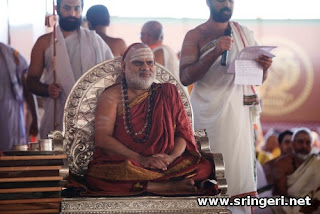 |
| Dr. Chandrashekhara Kambara with his family |
The selection of the poet, playwright and novelist Dr Chandrasekhar Kambar for the Jnanpith Award has strengthened the perception of ideological bias in the selection process that was suspected in the selection of previous two winners from Kannada, U.R. Anantha Murthy and Girish Karnad. Veteran wrtier Kambars choice has generated a feeling that Bhyrappa is being sidelined for his right-wing views. Out of the seven Jnanpith awardees so far in Kannada, all were giants except the last two - U.R. Anantha Murthy and Girish Karnad. It is now perceived that the award selection is being subtly influenced by so-called secularists with leftist leanings in recent years.
Churmuri blog has articulated the public feeling with clarity. The lobby of the secularists, here in Bangalore and there in Delhi, apparently has worked overtime to deprive a deserving candidate, S.L. Bhyrappa, a rightful place in the world of Kannada literature adorned with the ultimate stamp of recognition — a Jnanpith award. It is believed that S.L. Bhyrappa is branded as one with rightist orientation or as being a pro-Hindu in his writings. If this is so, one can also brand U.R. Anantha Murthy, Girish Karnad and Kambar as those with leftist orientation and as being anti-Hindu. No literature of creative kind should be evaluated on the basis of its ideology. It happens only in a totalitarian or a communist country. It should be evaluated on its pure literary quality — style, technic, use of language, rhetoric and above all, artistic merit. Further more, even if one takes into account the volume of works turned out by the last three winners of Jnanpith award, it is not comparable to other earlier winners and of S.L. Bhyrappa.
 |
| Dr. S. L. Bhyrappa |
Selection process for the Jnanapeetha Award
The process of selection begins with the submission of proposals by a large number of litterateurs, teachers, critics and discriminating readers, also from various universities, literary and language associations and other similar organisations. Once a language gets the award, it is not eligible for consideration during the next three years. Thus three languages are out of reckoning for the award every year. There is an Advisory Committee for each language, consisting of three eminent literary critics and scholars. These committees are reconstituted every three years. The proposals received are scrutinised by the concerned Language Advisory Committee. A Language Advisory Committee is not obliged to make its recommendations out of these proposals only. It is free to consider other writers before making its recommendation for the award. In fact, a Language Advisory Committee is expected to ensure that no deserving writer of the language concerned is left out of its consideration. A committee is expected to take into account the entire literary creativity of the author and evaluate it in the background of contemporary writing.
The rule has been slightly revised since the 18th Award. The works of a writer during the period of last 20 years, excluding the year for which the award is to be given, are taken into account for the award. The recommendations of various Language Advisory Committees are placed before the Selection Board. The Board consists of not less than seven and not more than eleven members, who are all of high repute and integrity. The Board, to begin with, was constituted by the Bharatiya Jnanpith Trust but, subsequently, vacancies continue to be filled in on the recommendations of the Selection Board itself. Each member has a term of three years but is eligible to continue for a further period of two more terms. Eminent scholars and writers of the country have become chairman or members of the Selection Board. The Selection Board makes a comparative evaluation of the recommendations of the Language Advisory Committees. The final selection is the result of comprehensive and in depth deliberations of the Selection Board. The entire responsibility for selection is that of the Selection Board.
Present Selection Board
1. Dr. Sitakant Mahapatra (Chairman)
2. Dr. K. Satchidanandan
3. Shri Gurdial Singh
4. Shri Keshubhai Desai
5. Shri Manager Pandey
6. Dr. Gopi Chand Narang
7. Shri Dinesh Misra (Ex-officio)
8. Shri Ravindra Kalia (Ex-officio)
Some of the prominent members in the past include Dr. Karan Singh, Smt. Rama Jain, Dr. Hazari Prasad Dwivedi, Dr. Vinayak K. Gokak (Chairman), Shri P.V. Narasimha Rao (Chairman), Dr. H.M. Nayak, Prof. U.R. Anantha Murthy, Shri M.T. Vasudevan Nair, Smt. Mahasveta Devi and Shri Ashok Vajpeyi









